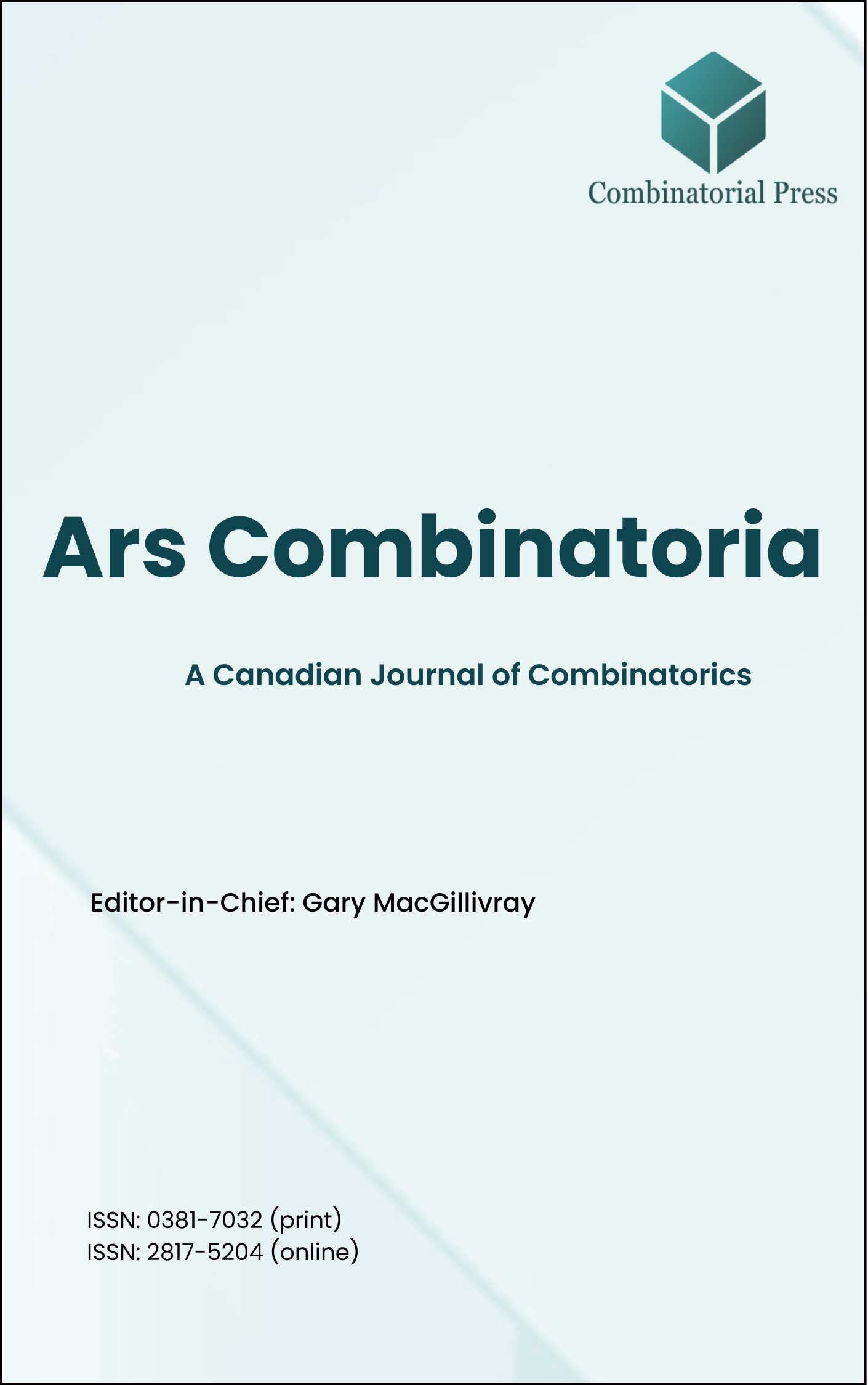
Ars Combinatoria
ISSN 0381-7032 (print), 2817-5204 (online)
Ars Combinatoria is the oldest Canadian Journal of Combinatorics, established in 1976. The journal is dedicated to advancing the field of combinatorial mathematics through the publication of high-quality research papers. From 2024 onward, it publishes four volumes per year in March, June, September and December. Ars Combinatoria has gained recognition and visibility in the academic community and is indexed in renowned databases such as MathSciNet, Zentralblatt, and Scopus. The Scope of the journal includes Graph theory, Design theory, Extremal combinatorics, Enumeration, Algebraic combinatorics, Combinatorial optimization, Ramsey theory, Automorphism groups, Coding theory, Finite geometries, Chemical graph theory but not limited.
Information Menu
- Research article
- Full Text
- Ars Combinatoria
- Volume 049
- Pages: 21-32
- Published: 31/08/1998
A graph \(G = (V, E)\) is a loop niche graph if there is a digraph \(D = (V, A)\)such that \(xy \in E\) iff there exists \(z \in V\) such that either \(xz\) and \(yz \in A\) or \(zx\) and \(zy \in A\). If \(D\) has no loops, \(G\) is a cyclic niche graph, and if \(D\) is acyclic, \(G\) is a niche graph. We give a characterization of triangle-free cyclic niche graphs, and apply this to classify grids.
- Research article
- Full Text
- Ars Combinatoria
- Volume 049
- Pages: 3-19
- Published: 31/08/1998
Let \(\Phi(N)\) be the maximum number of simple polygons that can be drawn using as vertices a set \(V\) of \(N\) points in the plane. By counting the number of simple polygons of a particular configuration of \(V\), an improved lower bound for \(\Phi(N)\) is obtained. It is proved that \(\Phi(N)^\frac{1}{N}\) is asymptotically greater than \(3.6\).
- Research article
- Full Text
- Ars Combinatoria
- Volume 048
- Pages: 307-317
- Published: 30/04/1998
A graph \(G\) is maximally non-hamiltonian \((MNH)\) if \(G\) is not hamiltonian but becomes hamiltonian after adding an arbitrary new edge. Bondy \([2]\) showed that the smallest size \((=\)number of edges) in a \(MNH\) graph of order \(n\) is at least \(\left\lceil\frac{3n}{2}\right\rceil\) for \(n \geq 7\). The fact that equality may hold for infinitely many \(n\) was suggested by Bollobas [1]. This was confirmed by Clark, Entringer, and Shapiro (see [5,6]) and by Xiaobui, Wenzhou, Chengxue, and Yuanscheng [8] who set the values of the size of smallest \(MNH\) graphs for all small remaining orders \(n\). An interesting question of Clark and Entringer [8] is whether for infinitely many \(n\) the smallest \(MNH\) graph of order \(n\) is not unique. A positive answer – the existence of two non-isomorphic smallest \(MNH\) graphs for infinitely many \(n\) follows from results in \([5], [4], [6]\), and \([8]\). But, there still exist infinitely many orders \(n\) for which only one smallest \(MNH\) graph of order \(n\) is known.
We prove that for all \(n \geq 88\) there are at least \(\tau(n) > 3\) smallest \(MNH\) graphs of order \(n\), where \(\lim_{n\to\infty} \tau(n) = \infty\). Thus, there are only finitely many orders \(n\) for which the smallest \(MNH\) graph is unique.
- Research article
- Full Text
- Ars Combinatoria
- Volume 048
- Pages: 297-306
- Published: 30/04/1998
We deal with \((a, d)\)-antimagic labelings of the prisms.
A connected graph \(G = (V, E)\) is said to be \((a, d)\)-antimagic if there exist positive integers \(a, d\) and a bijection \(f: E \to \{1, 2, \ldots, |E|\}\) such that the induced mapping \(g_f: V \to {N}\), defined by \(g_f(v) = \sum \{f(u, v): (u, v) \in E(G)\}\), is injective and \(g_f(V) = \{a, a + d, \ldots, a + (|V| – 1)d\}\).
We characterize \((a, d)\)-antimagic prisms with even cycles and we conjecture that prisms with odd cycles of length \(n\), \(n \geq 7\), are \((\frac{n+7}{2}, 4)\)-antimagic.
- Research article
- Full Text
- Ars Combinatoria
- Volume 048
- Pages: 289-296
- Published: 30/04/1998
We establish some basic facts about sign-patterns of orthogonal matrices, and use these facts to characterize the sign-nonsingular matrices which are sign-patterns of orthogonal matrices.
- Research article
- Full Text
- Ars Combinatoria
- Volume 048
- Pages: 283-288
- Published: 30/04/1998
In this paper, we give some properties of balanced labeling, prove that the graph \((m^2 + 1)C_4\) is balanced, and also solve the balanceness of snakes \(C_m(n)\).
- Research article
- Full Text
- Ars Combinatoria
- Volume 048
- Pages: 271-282
- Published: 30/04/1998
In this note, we verify two conjectures of Catlin in [J.Graph Theory \(13 (1989)465-483\)] for graphs with at most \(11\) vertices. These are used to prove the following theorem, which improves prior results in \([10]\) and \([13]\):
Let \(G\) be a 3-edge-connected simple graph with order \(n\). If \(n\) is large and if for every edge \(uv \in E(G)\), \(d(u) + d(v) \geq \frac{n}{6} – 2\), then either \(G\) has a spanning eulerian subgraph or $G$ can be contracted to the Petersen graph.
- Research article
- Full Text
- Ars Combinatoria
- Volume 048
- Pages: 257-270
- Published: 30/04/1998
Let \(G\) be a graph. A vertex subversion strategy of \(G\), \(S\), is a set of vertices in \(G\) whose closed neighborhood is deleted from \(G\). The survival-subgraph is denoted by \(G/S\). The vertex-neighbor-integrity of \(G\), \(VNI(G)\), is defined as:
\(VNI(G) = \min_{|S|} {|S| + w(G/S)}\)
where \(S\) is any vertex subversion strategy of \(G\), and \(w(G/S)\) is the maximum order of the components of \(G/S\). In this paper, we evaluate the vertex-neighbor-integrity of the powers of cycles, and show that among the powers of the \(n\)-cycle, the maximum vertex-neighbor-integrity is \(\left\lceil{2}\sqrt{n}\right\rceil – 3\) and the minimum vertex-neighbor-integrity is \(\left\lceil\frac{n}{2\left\lfloor\frac{n}{2}\right\rfloor} + 1\right\rceil\).
- Research article
- Full Text
- Ars Combinatoria
- Volume 048
- Pages: 245-256
- Published: 30/04/1998
What is the 2-packing number of the \(1 \times m \times n\) complete grid graph? Fisher solved this for \(1 \times m \times n\) grids for all \(m\) and \(n\). We answer this for \(2 \times m \times n\) grids for all \(m\) and \(n\), and for \(3 \times 3 \times n\), \(3 \times 4 \times n\), \(3 \times 7 \times n\), \(4 \times 4 \times n\), and \(5 \times 5 \times n\) grids for all \(n\). Partial results are given for other sizes.
- Research article
- Full Text
- Ars Combinatoria
- Volume 048
- Pages: 233-244
- Published: 30/04/1998
A Pandiagonal magic square (PMS) of order \(n\) is a square matrix which is an arrangement of integers \(0, 1, \ldots, n^2-1\) such that the sums of each row, each column, and each extended diagonal are the same. In this paper, we use the Step method to construct a PMS of order \(n\) for each \(n > 3\) and \(n\) is not singly-even. We discuss how to enumerate the number of PMSs of order \(n\) constructed by the Step method, and we get the number of nonequivalent PMSs of order \(8\) with the top left cell \(0\) is \(4,176,000\) and the number of nonequivalent PMSs of order \(9\) with the top left cell \(0\) is \(1,492,992\).





